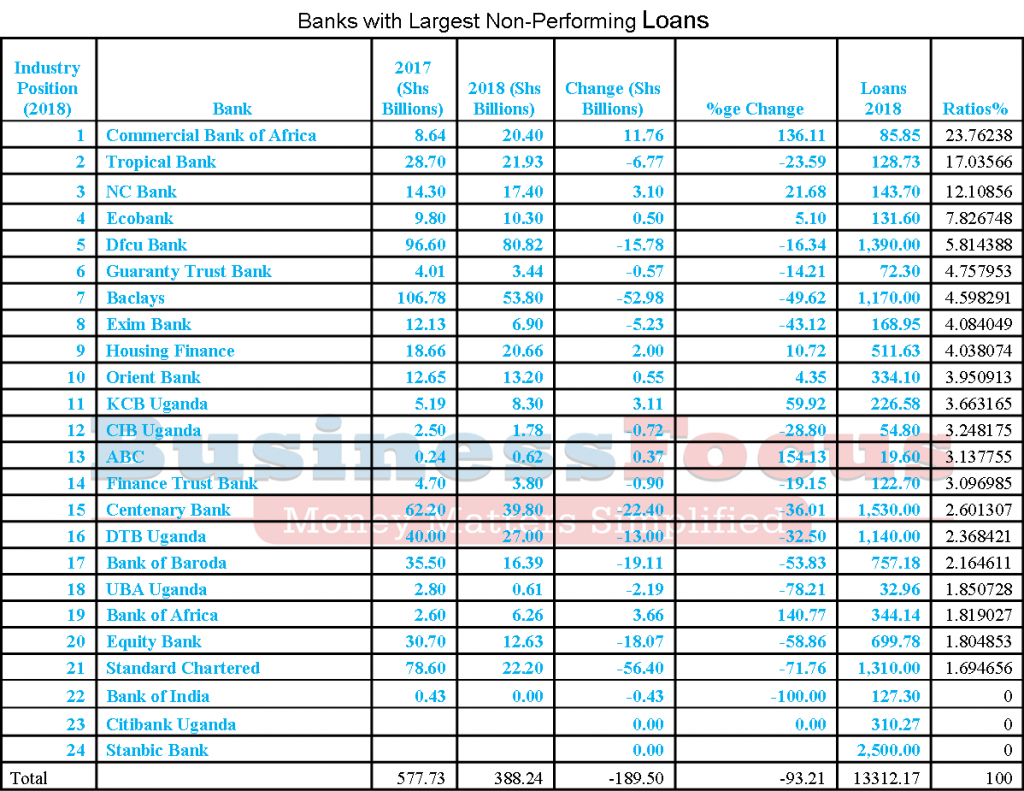Uganda’s banking sector continues to recover from turbulent times as witnessed by the increase in profits, lending, customer deposits as well as a reduction in Non-Performing Loans (NPLs) and bad loans written off.
According to the Bank of Uganda (BoU), the ratio of NPLs to total loans in the banking industry reduced from 5.6% as at the end of 2017 to 4.4 percent as at the end of September 2018.
The improvement in the banking sector is largely attributed to increased economic growth in 2018.
However, some banks continue to choke on high NPLs. According to BoU, NPLs are deemed too high when the ratio (of NPLs) to loans is above 5%.
Business Focus exclusively analysedall the 24 commercial banks to rank banks with largest NPLs basing on the 2018 financial statements. Citibank and Bank of India recorded nil NPLs while Stanbic didn’t indicate its NPLs.
Excluding the three banks, total industry NPLs reduced to Shs388.24bn in 2018, down from Shs577.73bn recorded in 2017.
ALSO READ:
2018 Results: Uganda’s Most Profitable, Loss-Making Banks Named
Shs28 Trillion Industry: Banks With Biggest, Smallest Assets Revealed
With a ratio of 23.7%, Commercial Bank of Africa tops banks with largest NPLs. Its NPLs stand at Shs20.4bn as of 31st December 2018 while loans advanced to customers stood at Shs85.85bn.
It is followed by Tropical bank whose NPLs ratio to loans is 17%. It recorded Shs21.93bn in NPLs in 2018 while its loans to customers stand at Shs128.73bn as of December 2018.
In 3rd position is NC Bank whose NPLs ratio to loans is 12.1%. It recorded Shs17.4bn in NPLs in 2018 against Shs143.7bn of loans advanced to customers.
Ecobank comes 4th with 7.8% ratio of NPLs to loans. It recorded Shs10.3bn in NPLs in 2018 against Shs131.6bn of loans advanced to customers.
With a NPLs ratio of 5.8%, dfcu bank is the 5th bank with largest NPLs.
It recorded Shs80.8bn in NPLs in 2018 against Shs1.39 trillion in loans advanced to customers.
Other banks that make up the top 10 banks with huge NPLs are Guaranty Trust Bank (4.75%), Barclays (4.59%), Exim Bank (4.084%), Housing Finance (4.038%) and Orient Bank (3.95%).
Check out our table to see where your bank lies in as far as banks with largest NPLs in Uganda are concerned.

Background to High NPLs In Uganda
Prior to the 2011 general elections, Uganda’s banking sector was generally stable and promising.
This was after new banks including Ecobank, Equity, KCB, United Bank for Africa and Global Trust Bank entered the Ugandan market at around the same time.
However, the 2011 election expenditure resulted into unprecedented inflation that crossed the 30% mark.
And in a move aimed at controlling the runway inflation, the Bank of Uganda (BoU) introduced a Monetary Tool called Central Bank Rate (CBR), a benchmark lending rate for commercial banks.
The CBR rose to over 20%, a move that saw commercial banks increase interest rates to over 30%.
Coupled with slowed business activity, this state of affairs resulted into many borrowers defaulting their loans, leading to increased industry Non-Performing Loans (NPLs) and write-offs.
Consequently, several banks recorded losses and others realized a reduction in profits.
It is therefore not surprising that industry NPLs increased to Shs529.3bn in 2013, up from Shs395.2bn in 2012.
It is also worth noting that industry NPLs have remained high since 2011, owing to the fact that economic recovery has been slow.
According to the World Bank, Uganda’s economic growth has averaged 5% in the last decade.
Additionally, still in 2011, the Shilling also hit a record low of 2900, further complicating business. The Local Unit has since been weakening against all major currencies. For the most part of 2018, it has been averaging 3700.
Apart from the domestic situation, the Civil War in South Sudan which started in 2011 has also had far reaching effects on the Ugandan economy.
A number of traders and businessmen who had taken bank loans found it difficult to service their loans, resulting into increased NPLs.
The above factors explain why a number of banks and companies have collapsed. In 2012, BoU took over the National Bank of Commerce over poor performance and in 2014; Global Trust Bank was also taken over after failing to become economically viable.
The latest bank to be taken over by BoU is Crane Bank in October 2016. This was after its NPLs increased by 122.9% in 2015. The bank’s NPLs increased to Shs142.3bn in 2015, up from Shs19.36bn in 2014.
The high NPLs saw Crane bank record a loss of Shs3.1bn in 2015, down from a net profit of Shs50.6bn in 2014.
It is also important to note that a number of companies, many of which had borrowed money from banks, became financially distressed in 2016, thus seeking government bailout.
This was after they had failed to pay back their loans and their properties were up for sale (auction) by banks.
However, Bank of Uganda (BoU) says NPLs have significantly reduced, pointing to the recovery of Uganda’s economy.
It also points to a brighter future for the banking sector.
The ratio of NPLs to total loans in the banking industry reduced from 5.3 percent at end March 2018 to 4.4 percent at end of June 2018. The CBR has also since been reduced to 9% and some banks have reduced their prime lending rates to as low as 17%.






